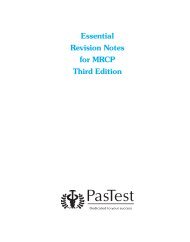SURGICAL FINALS Passing the Clinical - PasTest
SURGICAL FINALS Passing the Clinical - PasTest
SURGICAL FINALS Passing the Clinical - PasTest
- No tags were found...
You also want an ePaper? Increase the reach of your titles
YUMPU automatically turns print PDFs into web optimized ePapers that Google loves.
S E C T I O N 1Look for JACCOL (jaundice, anaemia, cyanosis, clubbing, oedema,lymphadenopathy) and examine <strong>the</strong> hands. In your systems approach payparticular attention to <strong>the</strong> system relevant to <strong>the</strong> presenting complaint.However, aim to be thorough; always take <strong>the</strong> pulse and blood pressure.Remember to test <strong>the</strong> urine. A dipstick should be provided.Observation, palpation, percussion and auscultation will have beenrepeatedly drummed into you by your teachers, and look, feel, move andmeasure for joints – this is not <strong>the</strong> time to forget <strong>the</strong>m! When palpating,always watch your patient’s face for distress, and apologise for causingany discomfort. When auscultating, warm <strong>the</strong> bell or diaphragm and tap<strong>the</strong> end to make sure that you are plugged into <strong>the</strong> right bit before youstart.An examiner may ask what you are doing at each stage; take this intoaccount when you are preparing with a colleague and do likewise. Whenyou have finished your examination make sure that <strong>the</strong> patient is coveredand comfortable.Thinking timeIf you are not being observed you will usually have a few minutes betweenexamining <strong>the</strong> patient and presenting your findings. During this time,reorganise any misplaced information and summarise <strong>the</strong> case in writing.You might also predict your examiners’ questions so that you are one stepahead. The sections on ‘typical cases’ in this book will help you to do this.Presenting your f indingsThe examiners will usually tell you what <strong>the</strong>y want. Normally <strong>the</strong>y will askyou to tell <strong>the</strong>m about <strong>the</strong> patient who you have just seen. They may adda rider such as ‘stick to <strong>the</strong> important features’. Don’t get flustered if <strong>the</strong>ystart with ‘What’s <strong>the</strong> diagnosis?’If your patient was a poor historian, start by commenting on this fact: thisis an important sign in itself and allowances will be made. However, it isno excuse for a poor presentation.Your presentation should be as concise, snappy and comprehensive aspossible. Place your notes in front of you for reference but talk, don’t read,10
















